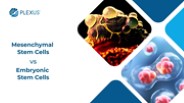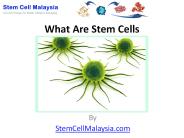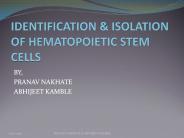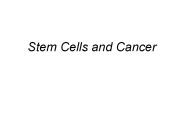Embryonic Stem Cells PowerPoint PPT Presentations
All Time
Recommended
1-56 of 1,835
Stem cells are undifferentiated and unique cells with the potential to develop into various specialized cell types in the body. They can be regarded as the building blocks of the body - capable of self-renewal and differentiation.
| PowerPoint PPT presentation | free to download
The Stem Cell Orthopedic Institute of Texas is a prime example of medical doctors who ONLY use adult stem cells in their procedures. Conveniently located in San Antonio, this medical team focuses on treating osteoarthritis, hip pain, knee pain, lumbar degenerative disc disease, and rotator cuff tears.
| PowerPoint PPT presentation | free to download
This presentation by Dr. David Greene provides an overview of the differences between human adult and embryonic stem cells. It covers topics such as the advantages and characteristics of each type of stem cell and its potential therapeutic applications. The presentation offers an accessible and informative introduction to the topic, making it an ideal resource for learners. This PPT is ideal for anyone looking for a basic understanding of the differences between adult and embryonic stem cells. Visit our website for more information.
| PowerPoint PPT presentation | free to download
Capable of developing into many (pluripotent) or any (totipotent) cell types ... Digested EB genome with PvuII to run through gel ...
| PowerPoint PPT presentation | free to view
Stem cell transplantation has been considered promising in treating problems related to several life-threatening diseases and disorders. Read this to know how are umbilical cord blood stem cells different. Visit https://www.cordlifeindia.com/ to know more about stem cells.
| PowerPoint PPT presentation | free to download
pulripotent - virtually can become any cell. type. Embryonic Stem cells ... Cells are then grown in laboratories. - Virtually they are made into any types of ...
| PowerPoint PPT presentation | free to view
If you have any interest in stem cells read here for more info http://stemcellorthopedicinstituteoftexas.com/adult-stem-cell-therapy/procedure-overview/
| PowerPoint PPT presentation | free to download
How does the PGD technique' circumvent the ethical issues ... Which of the following is a correct statement about pluripotent stem cells? ...
| PowerPoint PPT presentation | free to view
Stem cells are specialized cells that have the potential to develop into any type of cell in the body. Stem cell research has grown rapidly in recent years and has the potential to revolutionize the way we treat disease. In this presentation, Dr. David Greene r3 stem cell provides an in-depth exploration of the various types of stem cells and their potential uses in medical treatments.
| PowerPoint PPT presentation | free to view
Stem cells play a crucial role in the treatment of Alzheimer's disease by offering a promising avenue for regenerative medicine. In Alzheimer's, the brain experiences a progressive loss of neurons and synapses, leading to cognitive decline and memory impairment. Stem cell therapy aims to replenish these lost cells and restore the damaged neural circuitry. This PowerPoint presentation by Dr. David Greene R3 Stem Cell provides a basic overview of how stem cells play a crucial role in the treatment of Alzheimer's disease.
| PowerPoint PPT presentation | free to view
Visit Here: https://www.grandresearchstore.com/life-sciences/global-human-embryonic-stem-cells-hesc-market-size-status-and-forecast-2025 This report studies the global Human Embryonic Stem Cells (HESC) market size, industry status and forecast, competition landscape and growth opportunity. This research report categorizes the global Human Embryonic Stem Cells (HESC) market by companies, region, type and end-use industry.
| PowerPoint PPT presentation | free to download
STEM CELLS: The Upside and Downside of Stem Cell Science Human ES cell colony: picture provided by Dr. Toshihiko Ezashi * * * * * * * * * * * * 1997 Ian Wilmut ...
| PowerPoint PPT presentation | free to view
STEM CELLS IN SOLID TUMORS CANCER STEM CELL (CSC) What are stem cells? ** Stem cells are unspecialized immature cells that can renew themselves through cell division ...
| PowerPoint PPT presentation | free to view
Four E's: Eggs, Embryos, Embryonic Stem Cells, and Ethics. Carol Warner. Department ... 'Human Fertilisation and Embryology Authority' (HFEA)- allowed embryo ...
| PowerPoint PPT presentation | free to view
http://cryo-save.com/en/services/cryocord http://cryo-save.com/en/services/cryocord-1 Embryonic stem cells consists of cells which are pluripotent- capable of generating any cell/tissue in the body. Latest medical advancements prove that many terminal illness are treatable using embryonic stem cells. This makes embroyonic stem cell banking significant to child well being in the future. CRYOSAVE Arabia introduces mainly two type of banking stem cells from - umbilical cord blood and umbilical cord blood tissue. Secure your child's life with us. Visit us to know more about how we preserve stem cells.
| PowerPoint PPT presentation | free to download
MicroRNAs cloned from human embryonic stem cells. Total RNA ... (122 clones from 158) Most of the novel miRNAs from hES are expressed specifically in hES cells ...
| PowerPoint PPT presentation | free to view
Imaging the Structure of Mouse Embryonic Stem Cells
| PowerPoint PPT presentation | free to download
Esg1, expressed exclusively in preimplantation embryos germline, embryonic stem ... Frist choice Mouse Blot 1 and Mouse Embryo Stage Blot were hybridized with a ...
| PowerPoint PPT presentation | free to view
chemical and physical regulation of stem cells and progenitor cells: potential for cardiovascular tissue engineering (review) ngan f. huang, randall j. lee, song li
| PowerPoint PPT presentation | free to view
Stem Cells Why the Controversy Over Stem cells? Embryonic Stem cells are derived from extra blastocysts that would otherwise be discarded following IVF.
| PowerPoint PPT presentation | free to view
Stem cells Helena Fulkova Institute of Animal Science fulkova.helena@vuzv.cz
| PowerPoint PPT presentation | free to view
Stem cells Helena Fulkova Institute of Animal Science fulkova.helena@vuzv.cz
| PowerPoint PPT presentation | free to view
http://stemcellmalaysia.com/stem-cells/ Stem cells have actually set off a ton of interest not only in the clinical area yet additionally in individuals from every vocation. The major cause stem cells have stimulated so much attention is because of the belief that stem cell therapy has the potential to remedy numerous diseases. The pleasure has built up to additional chance when not curable conditions are believed to be treatable using stem cells. Many individuals anticipate the chance and appealing capacity of stem cell therapy for terminal diseases such as cancer as well as Acquired Immune Deficiency Syndrome. The excellent headlines of stem cell therapy are just as delighted for people with persistent health problems such as diabetes, Parkinson's condition, movement as well as lots of some other debilitating ailments.
| PowerPoint PPT presentation | free to download
Stem cells Helena Fulkova Institute of Animal Science fulkova.helena@vuzv.cz
| PowerPoint PPT presentation | free to view
Cloning ... Stem Cells
| PowerPoint PPT presentation | free to download
Slide 1 ... Stem Cells
| PowerPoint PPT presentation | free to download
Stem Cells Why the Controversy Over Stem cells? Embryonic Stem cells are derived from extra blastocysts that would otherwise be discarded following IVF.
| PowerPoint PPT presentation | free to view
Stem Cells What is a stem cell? Where do stem cells come from? What is a stem cell? A stem cell is a cell that: Is unspecialized Is capable of dividing and renewing ...
| PowerPoint PPT presentation | free to view
Stem cells are unspecialized cells of the human body. They can transform and/or multiply into specialized cells. Through a laboratory procedure known as differentiation stem cells procured from one part of the body can become/grow into other kinds of cells. They work to repair the body by generating healthy cells that can replace the cells damaged by disease
| PowerPoint PPT presentation | free to download
Stem Cells The Biotech issue that may no longer be an issue. ... Therapeutic Cloning Dedifferentiate: return to an undecided or undifferentated state.
| PowerPoint PPT presentation | free to download
Science News. Public Framing. Patient's Own Stem Cells Provide a Tailor-Made Jawbone ... Breakthrough Isolating Embryo-quality Stem Cells From Blood (Science Daily) ...
| PowerPoint PPT presentation | free to view
Stem cells have the remarkable potential to develop into many different cell types in the body. ... Bone/cartilage deformities children with osteogenesis imperfecta ...
| PowerPoint PPT presentation | free to view
Peripheral Blood Apheresis. 12. Stem Cells. How do you get them? ... Apheresis or Centrifugal Device. Storage. Manipulation and Cryopreservation. 19. Stem Cells ...
| PowerPoint PPT presentation | free to view
... stem cell research on cell lines prior to speech. Recent Stem Cell Research ... created the first state-funded stem cell research center with $11.5 million ...
| PowerPoint PPT presentation | free to view
isolation and identification of hematopoetic stem cell
| PowerPoint PPT presentation | free to download
... at WiCell Research institute recently published work that eliminates the ... Mouse ESC have been induced to make dopamine-producing cells in rats with ...
| PowerPoint PPT presentation | free to view
Stem cells are unspecialized cells of the human body. Procured from one part of the body, they can differentiate and become/grow into other kinds of cells, including specialized cells. Our body has the unique ability to self-heal. Illness, injury, or disease can disrupt this ability. Stem cells have the power to remind our body of its self-healing capabilities, and supports this process by growing/dividing into healthy cells that can replace the cells damaged by disease.
| PowerPoint PPT presentation | free to download
Stem Cells What are they and what can we do with them? Stem Cell Characteristics They are undifferentiated cells that can divide indefinitely in culture.
| PowerPoint PPT presentation | free to view
Stem Cells Implications for Catholic Health Care Philip Boyle, Ph.D. Vice President, Mission & Ethics www.CHE.ORG/ETHICS Obligations of Catholic institutions Existing ...
| PowerPoint PPT presentation | free to view
Stem Cells and Cancer Human development: a stem cell hierarchy Developmental hierarchies: the hematopoietic system Embryonic versus adult Isolated from early embryos ...
| PowerPoint PPT presentation | free to download
Pluripotent Stem Cells
| PowerPoint PPT presentation | free to view
Stem Cells and Regenerative Medicine At the beginning of embryonic development, stem cells undergo symmetric cell division. They divide symmetrically, where one cell ...
| PowerPoint PPT presentation | free to view
Neural stem cells are undifferentiated, self-renewing and multipotent cells. They have the ability to differentiate into neuronal neurons, oligodendrocytes, and astrocytes. They are found in abundance throughout the central nervous system (CNS). Neural stem cell transplantation can help repair and replenish damaged oligodendrocytes, as well as other brain tissue
| PowerPoint PPT presentation | free to download
One of the best characterized stem cells ... Able to differentiate into cells of all 3 germ layers: endoderm, ectoderm, and mesoderm ...
| PowerPoint PPT presentation | free to view
Stem Cells and Regenerative Medicine So if growth factors and hormones affect stem cell functions, then our lifestyles . our experiences and behaviors . are also ...
| PowerPoint PPT presentation | free to view
Stem Cells and Regenerative Medicine
| PowerPoint PPT presentation | free to download
Just like the stem of a plant will produce branches, leaves, and flowers, so ... together in the depths of the earth, Your eyes saw my. unformed body. ...
| PowerPoint PPT presentation | free to view
The purpose of this article is to dispel common myths about stem cells. Know the importance of stem cells to secure the baby's as well as entire family's healthy future. You can also visit this link, https://www.cordlifeindia.com/about-stem-cells
| PowerPoint PPT presentation | free to download
Stem Cell Therapy Most stem cell therapies are in the ... different cells express different subsets of genes Somatic cells Germ line cells Totipotency Capability of ...
| PowerPoint PPT presentation | free to view
Stem Cells and Cloning Two Types Embryonic- created by means of in vitro fertilization. They are harvested after 5-6 days from a cell know as a blastocyst.
| PowerPoint PPT presentation | free to download
Unipotent stem cell, a term that is usually applied to a cell in adult organisms, ... differentiated, undamaged tissues are typically unipotent and give rise to just ...
| PowerPoint PPT presentation | free to view
Cells initiating acute myeloid leukemia. after transplantation into SCID mice ... AML (acute myeloid leukemia) medulloblastomas. glioblastomas. colon cancer ...
| PowerPoint PPT presentation | free to view
Today, there is new evidence that stem cells are present in far more tissues and ... skeletal muscle (also derived from mesoderm) and neurons (derived from ectoderm) ...
| PowerPoint PPT presentation | free to view
The umbilical cord blood stem cells are also more ‘immunologically naïve’ than bone marrow stem cells as they have not been exposed to outside immune stimulation (such as infections). In allogeneic transplants (such as between siblings) they are less likely to cause the transplant-related complication of graft-versus-host disease.
| PowerPoint PPT presentation | free to download
STEM CELLS: OPPORTUNITIES AND CHALLENGES
| PowerPoint PPT presentation | free to view
Stem cell research with: ... Leading stem cell researchers and research institutes. ... Has more than 30 stem cell research groups and 300 people at nine ...
| PowerPoint PPT presentation | free to view
























































